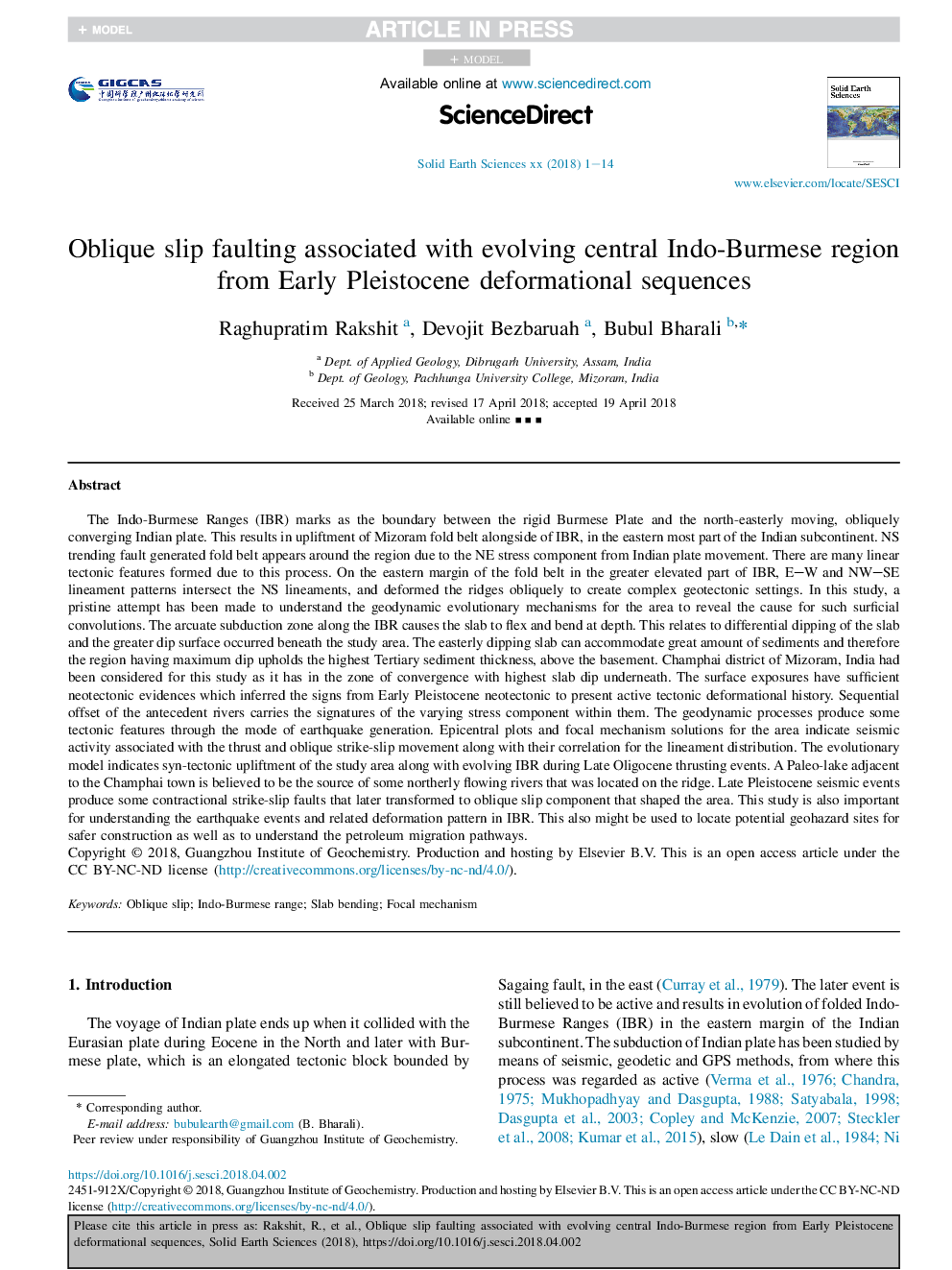| کد مقاله | کد نشریه | سال انتشار | مقاله انگلیسی | نسخه تمام متن |
|---|---|---|---|---|
| 8912839 | 1639874 | 2018 | 14 صفحه PDF | دانلود رایگان |
عنوان انگلیسی مقاله ISI
Oblique slip faulting associated with evolving central Indo-Burmese region from Early Pleistocene deformational sequences
دانلود مقاله + سفارش ترجمه
دانلود مقاله ISI انگلیسی
رایگان برای ایرانیان
کلمات کلیدی
موضوعات مرتبط
مهندسی و علوم پایه
علوم زمین و سیارات
ژئوشیمی و پترولوژی
پیش نمایش صفحه اول مقاله

چکیده انگلیسی
The Indo-Burmese Ranges (IBR) marks as the boundary between the rigid Burmese Plate and the north-easterly moving, obliquely converging Indian plate. This results in upliftment of Mizoram fold belt alongside of IBR, in the eastern most part of the Indian subcontinent. NS trending fault generated fold belt appears around the region due to the NE stress component from Indian plate movement. There are many linear tectonic features formed due to this process. On the eastern margin of the fold belt in the greater elevated part of IBR, E-W and NW-SE lineament patterns intersect the NS lineaments, and deformed the ridges obliquely to create complex geotectonic settings. In this study, a pristine attempt has been made to understand the geodynamic evolutionary mechanisms for the area to reveal the cause for such surficial convolutions. The arcuate subduction zone along the IBR causes the slab to flex and bend at depth. This relates to differential dipping of the slab and the greater dip surface occurred beneath the study area. The easterly dipping slab can accommodate great amount of sediments and therefore the region having maximum dip upholds the highest Tertiary sediment thickness, above the basement. Champhai district of Mizoram, India had been considered for this study as it has in the zone of convergence with highest slab dip underneath. The surface exposures have sufficient neotectonic evidences which inferred the signs from Early Pleistocene neotectonic to present active tectonic deformational history. Sequential offset of the antecedent rivers carries the signatures of the varying stress component within them. The geodynamic processes produce some tectonic features through the mode of earthquake generation. Epicentral plots and focal mechanism solutions for the area indicate seismic activity associated with the thrust and oblique strike-slip movement along with their correlation for the lineament distribution. The evolutionary model indicates syn-tectonic upliftment of the study area along with evolving IBR during Late Oligocene thrusting events. A Paleo-lake adjacent to the Champhai town is believed to be the source of some northerly flowing rivers that was located on the ridge. Late Pleistocene seismic events produce some contractional strike-slip faults that later transformed to oblique slip component that shaped the area. This study is also important for understanding the earthquake events and related deformation pattern in IBR. This also might be used to locate potential geohazard sites for safer construction as well as to understand the petroleum migration pathways.
ناشر
Database: Elsevier - ScienceDirect (ساینس دایرکت)
Journal: Solid Earth Sciences - Volume 3, Issue 3, September 2018, Pages 67-80
Journal: Solid Earth Sciences - Volume 3, Issue 3, September 2018, Pages 67-80
نویسندگان
Raghupratim Rakshit, Devojit Bezbaruah, Bubul Bharali,